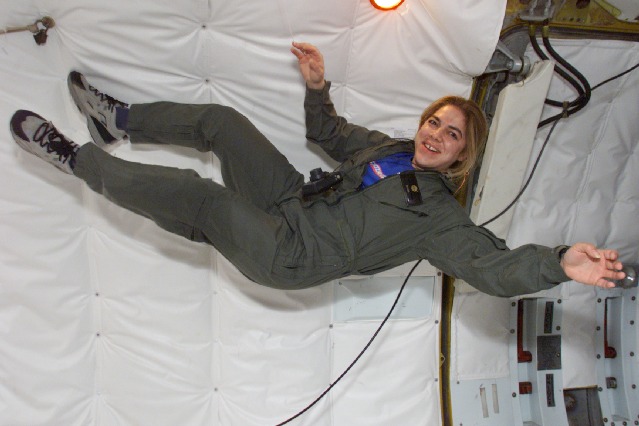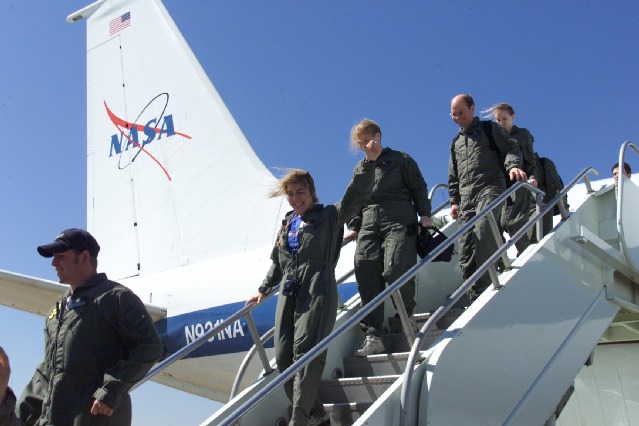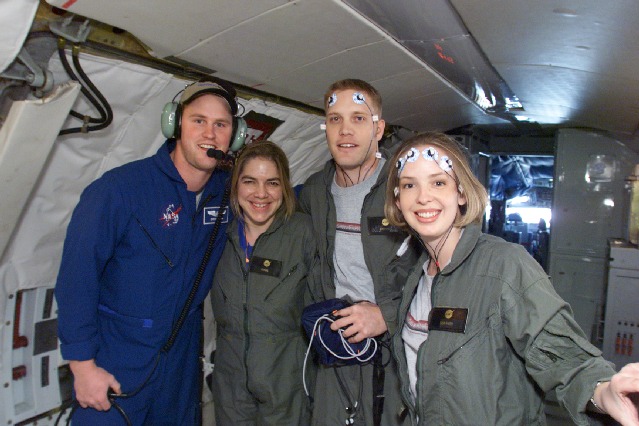Rita Karl, reporting for spacekids.com
3.11.00
So you want to be weightless?
The NASA KC-135 airplane (affectionately
known as the vomit comet) can
allow you to experience weightlessness
like the astronauts! The' Fly
High' program, now in it's fourth
year, offers high school and college
students the chance to design an
experiment and fly it in the same
zero-gravity environment that astronauts
use to train in before they go
into space. The KC-135 airplane
is a large padded laboratory that just
happens to fly parabolas (curves)
simulating 20 seconds of weightless at
a time at the top of the curve.
Spacekids.com reporter Rita Karl
flew with a team from Texas A&M
University. The team was made
up of three engineering students who
designed a simulated cockpit to
study the reaction times of astronauts
in zero-g. Students Susan
Ramsey, Bo Beeman and Bowie Hand worked for
one year to perfect a cockpit which
times how long it takes an astronaut
to reach for and flip a variety
of switches. This movement time study
was designed to find out if new
astronauts would have difficulty
reacting in a zero-g environment
if an emergency occurred. It usually
takes rookie astronauts several
hours to adjust to moving in zero-g.
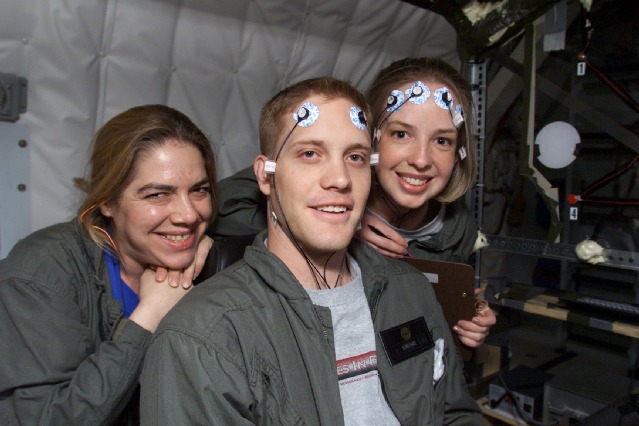
Rita, Bowie and Susan
One side effect of weightlessness
is 'space sickness' which is related
to motion sickness. Your inner ear,
which regulates how your body knows
what is up or down becomes very
confused in zero-g and causes some
people to get sick on this plane
and in space. Susan mentioned before
the first flight that she was "more
worried about the test subjects than
the experiment". After flying
the experiment twice she said that she
felt the 'exact opposite'!
None of the team members got sick at all but
the human muscular recording system
failed twice due to battery
problems. The cockpit electrical
timer and switching system worked
perfectly however and they got more
data than they expected. Test
subject Bowie who was a first time
flyer felt that it was harder to
react in zero-g. Susan who
has had experience flying the zero-g plane
before thought it was easier.
The team's college advisor Dr. Bill Hyman
said 'I have watched this group
put together this experiment largely on
their own... and they did a fantastic
job!"
"Zero-g and I feel fine!"
The next day I flew with the team!
I sat in the cockpit for takeoff and
enjoyed watching the aircraft commander
doing her 'right stuff". As we
were approaching the first parabola
things got quiet in the cabin (8
teams were flying, 16 students)
and we held on tight. The flight
surgeon smiled and told me the first
one would be the 'kicker' and he
was right. I was holding on
to the experiment, and then my legs flew up
behind me. I let go of the bar and
it was unbelieveable, I was
floating! At first I had the
sensation of going over the top of a
roller coaster but that vanished
immediately. It was replaced by an
indescribably free feeling
No restraints holding you down! I was
floating and so was everything else!
My camera rose up in front of me.
I felt safe and relaxed and completely
at home.
Suddenly the cry of "Feet down, coming
out!" was followed by a distinct
g-force pressing me to the floor.
Everyone stayed still until the
second parabola and then the excited
students begin cheering! We did a
video interview introducing the
students, Bowie and Susan, and the
experiment (soon to be available
here at spackids.com!) and tried out
the first of my physics toys, the
space yoyo.
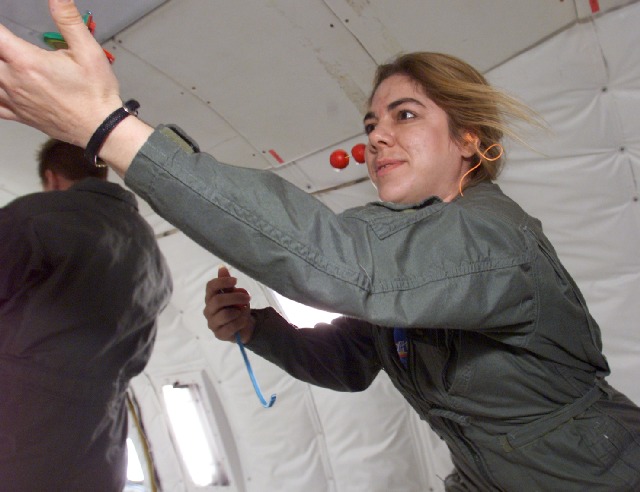
The space yo-yo did not work in zero-g
because it relies on gravity to
make the bottom ball orbit the middle
ball. However, the regular yo-yo
worked like a charm as long as you
didn't let it sleep! The gyroscope
also worked perfectly and did not
tumble. Trying to stay near it was the
challenge, because every time you
pushed off a wall you kept on going!
The bubbles were fun, surface tension
being evenly applied all around
making them stronger - although
they all crashed to the floor at the end
of the parabola! Water from
my water bottle formed perfect spheres,
which splattered upon return to
gravity.
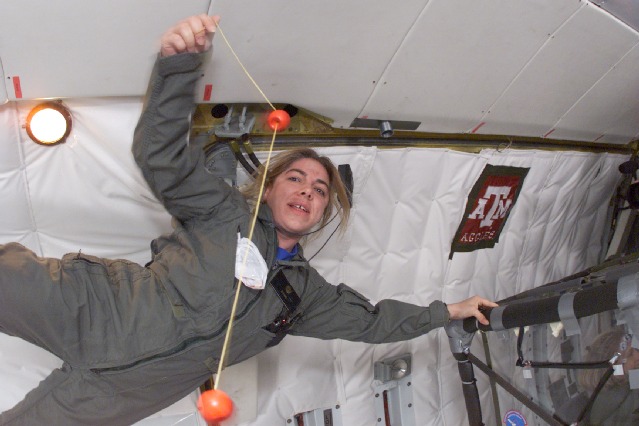
Heavy Lifting
The zero-g plane pulls up very steeply
and you experience 2-g's for a
short period of time. This makes
your body and all of your things feel
twice as heavy as usual. I asked
to sit in the cockpit and watched the
horizon line vanish and the sky
turn bluer until we pitched over and
everything became weightless.
Then I could see the horizon line and
then the Gulf of Mexico. It
looked like we were heading straight down
for a crash! But the pilot
effortlessly pulled the plane back up for
the next maneuver.
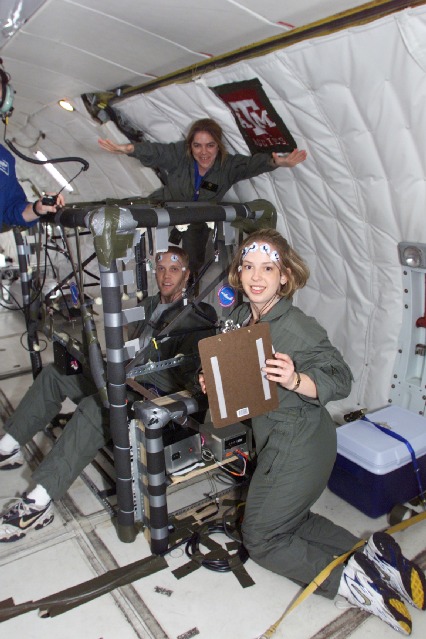
During the 30 zero-g parabolas we
all tried different moves to see how
much control we had over our bodies.
Not much! You immediately lose
track of what is up or down.
The only points of reference are other
floating bodies and experiments
bolted to the floor. I loved it! I
did NOT want to come back to gravity!
It was mesmerizing and very
comfortable.
At the end of the flight the pilots
simulated moon gravity (1/6th g) for
one parabola which was really amazing,
I felt so light! Susan did
push-ups with our entire team on
her back! Then we did one parabola in
Mars gravity (1/3rd g). These
were great because you could jump so high
and do handstands without any effort
at all! Gymnastics on Mars will be
awesome! I can promise you
people who have experienced Mars gravity
will be the first to sign up to
go. This was an incredible experience,
and a great opportunity for students
who are interested in space.
The program is sponsored by the
Texas Space Grant Consortium. For more
information on how you can participate
visit their website at
http://www.tsgc.utexas.edu/floatn/
